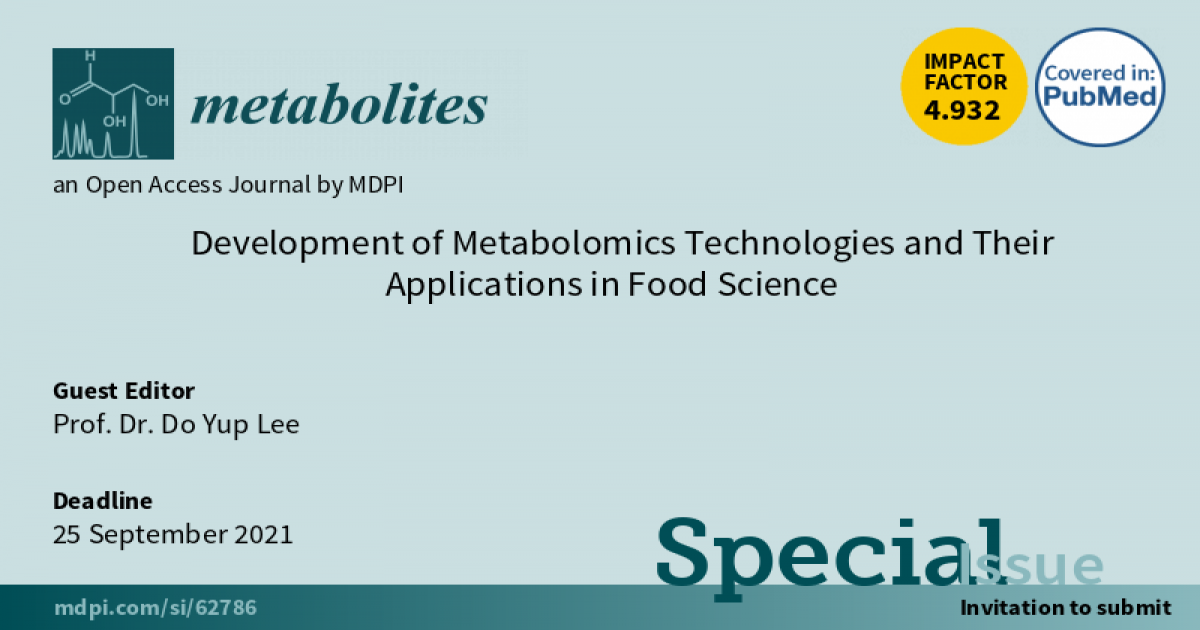Development of Metabolomics Technologies and Their Applications in Food Science
A special issue of Metabolites (ISSN 2218-1989). This special issue belongs to the section "Food Metabolomics".
Deadline for manuscript submissions: closed (25 September 2021) | Viewed by 13640

Special Issue Editor
Special Issue Information
Dear Colleagues,
Food provides essential nutrients, pleasurable flavours, and physiological functions that influences on human health interactively with other factors (e.g., genotype). The roles are fulfilled by “metabolites” that are defined as small molecules (<2000 Da). Metabolomics is the ideal technology that determines and evaluates the quantitative features of metabolites pertained in a range of biological contexts including “food matrix”.
Accordingly, the Special Issue invites papers covering a range of topics regarding metabolomic application to food science, which includes but is not limited to food safety, food processing, food quality control, functional food, and food microbiology (fermented food). The topic may also include method development in analytical procedure and computational processing.
Prof. Dr. Do Yup Lee
Guest Editor
Manuscript Submission Information
Manuscripts should be submitted online at www.mdpi.com by registering and logging in to this website. Once you are registered, click here to go to the submission form. Manuscripts can be submitted until the deadline. All submissions that pass pre-check are peer-reviewed. Accepted papers will be published continuously in the journal (as soon as accepted) and will be listed together on the special issue website. Research articles, review articles as well as short communications are invited. For planned papers, a title and short abstract (about 100 words) can be sent to the Editorial Office for announcement on this website.
Submitted manuscripts should not have been published previously, nor be under consideration for publication elsewhere (except conference proceedings papers). All manuscripts are thoroughly refereed through a single-blind peer-review process. A guide for authors and other relevant information for submission of manuscripts is available on the Instructions for Authors page. Metabolites is an international peer-reviewed open access monthly journal published by MDPI.
Please visit the Instructions for Authors page before submitting a manuscript. The Article Processing Charge (APC) for publication in this open access journal is 2700 CHF (Swiss Francs). Submitted papers should be well formatted and use good English. Authors may use MDPI's English editing service prior to publication or during author revisions.
Keywords
- Food science & technology
- Bioactive compound
- Biomarker
- Quality control
- Agricultural crop
- Fermented food
- Multi-omics
- Mass-spectrometry
- Machine learning
Benefits of Publishing in a Special Issue
- Ease of navigation: Grouping papers by topic helps scholars navigate broad scope journals more efficiently.
- Greater discoverability: Special Issues support the reach and impact of scientific research. Articles in Special Issues are more discoverable and cited more frequently.
- Expansion of research network: Special Issues facilitate connections among authors, fostering scientific collaborations.
- External promotion: Articles in Special Issues are often promoted through the journal's social media, increasing their visibility.
- e-Book format: Special Issues with more than 10 articles can be published as dedicated e-books, ensuring wide and rapid dissemination.
Further information on MDPI's Special Issue polices can be found here.






